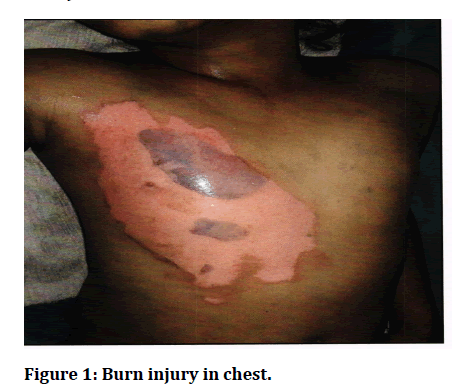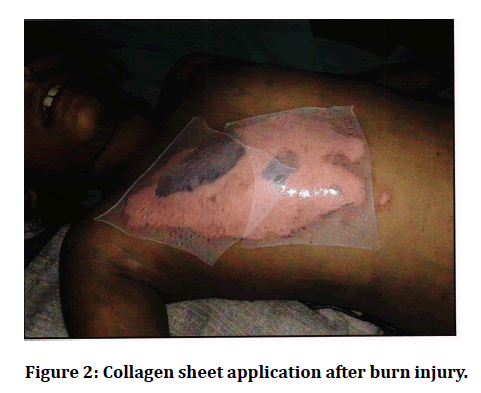Research - (2021) Volume 9, Issue 7
A Study of Recent Trend of Collagen Sheet Dressing in Ulcer Management
K Barathiraja and Gopalsamy Santhanam Prabudoss*
*Correspondence: Gopalsamy Santhanam Prabudoss, India,
Abstract
The study of wound healing has undergone very drastic changes in the last two decades. In this study of collagen sheet dressing in 94 patients of ulcer management were performed. Out of 94 patients, 57 patients were male, and 39 patients were female. Type of ulcer noted in this study are 49 patients m traumatic ulcer, 32 patients in diabetic ulcers, 12 patients in burns ,1patient in tropic ulcer. Collagen sheet dressing can be applied immediately upon soaking in sterile water or normal saline solution for 2 to 3 minutes. It does not require any pre-treatments or extensive washing to remove preservatives, etc as in others. Collagen sheet dressing reduces the wound pain significantly compared to other dressings and accelerating tissue remodelling without causing irritation.
Keywords
Healing, Wound, Empirical basis.
Introduction
Every living organism can repair its injuries, but some wounds are difficult to repair such as diabetes ulcer, venous ulcer, pressure sore and burns. These wounds if left untreated will cause pain, requires hospital stay or even surgeries, to avoid these wound dressings are recommended. Mostly the decisions on the patient wound healing problems were generally made on an empirical basis and on historical observations. Every material & method known to man has been tested or used to facilitate or accelerate the wound healing. The aim of clinical wound healing is safe and better results. Currently there are various options available for wound healing. The aim of the clinical wound healing is for safe and easier way of healing process. This study was conducted to compare the wound healing with collagen dressing and other dressings. Collage in an important component of the connective tissues, the main reason for collagen being a choice is, it just leaves a scare after healing that’s only collagen fibres. Hence this study aims to analysis the case presentation, predisposing factor, co-morbid disease, microbiology, surgical management, and outcome of ulcer management [1-6].
Materials and Methods
Study design
Study place: Sree Balaji Medical College & Hosp IT AL , Chennai, India.
Study population
Patient with nonspecific ulcer like diabetic foot ulcers, traumatic ulcers & superficial burns.
Sample size
96 patients.
Inclusion criteria
- Patient with ulcer in any part of body.
- Burns.
Exclusion criteria
- Critically ill patient. 2.Patient refusal.
- Any evidence of underlying infection.
- Any evidence of underlying bone osteomyelitis.
- Malignancy.
Methodology
Patient with any type of ulcer or burns were taken for the study. Wound cleaning/debridement was done. 94 patients,39 patients were male, and 57 patients were female. Wound cleaning/debridement was done. Every day dressing done and noted for the regression of size of ulcer, ulcer bed, granulation tissue, according to the cause of ulcer collagen sheet was applied. Every day dressing done and noted for the regression of size of ulcer, ulcer bed, granulation tissue, according to the cause of ulcer collagen sheet was applied.
Results
The outcome of wound healing by using collagen sheet dressing in the study population is good. Out of 94 patients only 10 cases got infected. Most of the cases are treated by single dressing per day. Cost of dressing 1s exceptionally low, when compared to other dressings. Hospital stay is short while using collagen sheet dressing. 24% cases are treated in a day care admission (Figures 1 and 2).

Figure 1: Burn injury in chest.

Figure 2: Collagen sheet application after burn injury.
Discussion
As collage form the important component of the connective tissues its of special importance to the skin. A study conducted by Dr. M. Ramula concluded Collagen sheet dressing is advantageous in all the aspects when compared to conventional methods. Previous studies also concluded from his study that collage treatment is a safer treatment for wound healing. Collagen sheet dressing reduces the wound pam significantly compared to other dressings and accelerating tis sue remodelling without causing irritation. Collagen sheet dressing reduces the repeated dressings, prolonged hospital stays and has been shown to reduce the overall wound treatment cost. It reduces the pain and increases the healing rate [1-11].
Conclusion
Biological dressings like collagen sheet are impermeable to bacteria and create the most physiological interface between the wound surface and the environment. Collagen sheet dressings have other advantages over conventional dressings in terms of ease of application and being natural, non-immunogenic, non-pyrogenic, hypo allergenic, and pain-free. Collagen sheet dressing is especially useful in Partial and full thickness wounds, Pressure ulcers, Diabetic ulcers, trauma wounds like abrasions, lacerations, second-degree burns. This study concludes that collagen sheet has a better healing property Collagen enhances better granulation tissue. Collagen is equally effective in all types of nonspecific ulcers. Collagen sheet dressing reduces the wound pain.
Funding
No funding sources.
Ethical Approval
The study was approved by the Institutional Ethics Committee.
Conflict of Interest
The authors declare no conflict of interest.
Acknowledegements
The encouragement and support from Bharath Institute of Higher Education and Research, Chennai, is gratefully acknowledged. For provided the laboratory facilities to carry out the research work.
References
- Rao H, Pai A, Hussein I, et al. A comparative study between collagen dressings and conventional dressings in wound healing. Int J Collaborative Res Internal Med Public Health 2012; 4.
- Sandeman SR, Allen MC, Liu C, et al. Human keratocyte migration into collagen gels declines with in vitro ageing. Mechanisms Ageing Develop 2000; 119:149-57.
- Sarabahi S. Recent advances in topical wound care. Indian J Plastic Surg 2012; 45:379-87.
- Lazovic G, Colic M, Grubor M, et al. The application of collagen sheet in open wound healing. Ann Burns Fire Disasters 2005; 18:151–6
- Horch RE, Stark GB. Comparison of the effect of a collagen dressing and polyurethane dressing on healing of split thickness skin graft donor sites. Scand J Plast Reconst Surg Hand Surg 1998; 32:407–13.
- Veves A, Sheehan P, Pham HT. A randomized, controlled trial of promogran (a collagen/oxidized regenerated cellulose dressing) vs standard treatment in the management of diabetic foot ulcers. Arch Surg 2002; 137:822–7.
- Nataraj C, Ritter G, Dumas S, et al. Extra cellular wound matrices: Novel stabilization and sterilization method for collagen-based biologic wound dressings. Wounds 2007; 19:148–56.
- Motta G, Ratto GB, De Barbieri A, et al. Can heterologous collagen enhance the granulation tissue growth? An experimental study. Ital J Surg Sci 1983; 13:101–108.
- Chung J, Wang XQ, Lindberg FP, et al. Thrombospondin-1 acts via IAP/CD47 to synergize with collagen in alpha 2 beta 1-mediated platelet activation. Blood 1999; 94:642–648.
- Ramakrishnan KM, Jayaraman V. Management of partial-thickness burn wounds by amniotic membrane: A cost effective treatment in developing countries. Burns 1997; 23:33–6.
- Hadjiiski O, Anatassov N. Amniotic membranes for temporary burn coverage. Ann Burns Fire Disasters 1996; 9:88–92.
Author Info
K Barathiraja and Gopalsamy Santhanam Prabudoss*
India
Citation: K Barathiraja, Gopalsamy Santhana Prabudoss, A Study of Recent Trend of Collagen Sheet Dressing in Ulcer Management, J Res Med Dent Sci, 2021, 9(7):394-396
Received: 07-Jul-2021 Accepted: 22-Jul-2021
